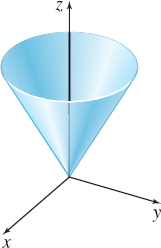15.8 Assess Your UnderstandingPrinted Page 1044
Concepts and Vocabulary
True or False The divergence of a vector field F is a vector.
False
If F(x,y,z)=P(x,y,z)i+Q(x,y,z)j+R(x,y,z)k is a vector field, where ∂P∂x, ∂Q∂y, and ∂R∂z each exist, then divF=__________.
∂P∂x+∂Q∂y+∂R∂z
Skill Building
In Problems 3–8, find the divergence of F.
F(x,y,z)=x2i+y2j+z2k
div F=2x+2y+2z
F(x,y,z)=xi+xyj+xyzk
F(x,y,z)=(x+cosx)i+(y+ysinx)j+2zk
div F=4
F(x,y,z)=xyezi+x2ezj+x2yezk
F(x,y,z)=√x2+y2i+√x2+y2j+zk
div F=x+y√x2+y2+1
F(x,y,z)=xy2i+x2yj+xyzk
In Problems 9–18, use the Divergence Theorem to find ∬, where \mathbf{n} is the outer unit normal vector to S.
\mathbf{F}=(2xy+2z)\mathbf{i}+(y^{2}+1)\mathbf{j} -(x+y)\mathbf{k}; S is the surface of the solid enclosed by x+y+z=4, x=0, y=0, and z=0.
\displaystyle{{128} \over 3}
\mathbf{F}=(2xy+z)\mathbf{i}+y^{2}\mathbf{j}-(x+4y)\mathbf{k} ; S is the surface of the solid enclosed by 2x+2y+z=6, x=0, y=0, and z=0.
\mathbf{F}=x^{2}\mathbf{i}+y^{2}\mathbf{j}+z^{2}\mathbf{k}; S is the surface of the solid enclosed by x=0, x=1, y=0, y=1, z=0 , and z=1.
3
\mathbf{F}=(x-y)\mathbf{i}+(y-z)\mathbf{j}+(x-y)\mathbf{k}; S is the surface of the solid cube with its center at the origin and faces in the planes x=\pm 1, y=\pm 1, and z=\pm 1.
\mathbf{F}=x^{2}\mathbf{i}+2y\mathbf{j}+4z^{2} \mathbf{k}; S is the surface of the solid cylinder x^{2}+y^{2}\leq 4, 0\leq z\leq 2.
80\pi
\mathbf{F}=x\mathbf{i}+2y^{2}\mathbf{j}+3z^{2}\mathbf{k}; S is the surface of the solid cylinder x^{2}+y^{2}\leq 9, 0\leq z\leq 1.
\mathbf{F}=x\mathbf{i}+y\mathbf{j}+z\mathbf{k}; S is the sphere x^{2}+y^{2}+z^{2}=1.
4\pi
\mathbf{F}=2x\mathbf{i}+2y\mathbf{j}+2z\mathbf{k}; S is the sphere x^{2}+y^{2}+z^{2}=2.
\mathbf{F}=(x+\cos x)\mathbf{i}+(y+y\sin x)\mathbf{j}+2z \mathbf{k}; S is the surface of the solid enclosed by the tetrahedron with vertices (0,0,0),(1,0,0),(0,1,0), and (0,0,1).
\displaystyle{2 \over 3}
\mathbf{F}=yz\mathbf{i}+xz\mathbf{j}+xy\mathbf{k}; S is the surface of the solid enclosed by the tetrahedron with vertices (0,0,0),(1,0,0),(0,1,0), and (0,0,1).
Applications and Extensions
Volume Let \mathbf{F}=x\mathbf{i}+y\mathbf{j}+z\mathbf{k}; let S be the surface of a solid E satisfying the Divergence Theorem; and let \mathbf{n} be the outer unit normal vector to S. Show that the volume V of E is given by the formula V=\dfrac{1}{3}\iint\limits_{S} \mathbf{F}\,{\bf\cdot}\, \mathbf{n}\,dS.
See Student Solutions Manual.
1045
Volume In Problems 20–22, use the formula given in Problem 19 to find each volume.
A rectangular parallelepiped with sides of length a,b, and c
A right circular cone with height h and base radius R
(Hint: The calculation is simplified with the cone oriented as shown in the figure.)

V = \displaystyle{1 \over 3}\pi R^2h
A sphere of radius R
In Problems 23 and 24, find \iint\limits_S \mathbf{F}\,{\bf\cdot}\, \mathbf{n}\,dS and \iiint\limits_{E}{\rm{div}}\,\mathbf{F}\, dV separately and verify the Divergence Theorem.
\mathbf{F}(x,y,z)=x\mathbf{i}+y\mathbf{j}+z\mathbf{k}; S is the surface of the sphere x^{2}+y^{2}+z^{2}=100.
4000\pi
\mathbf{F}(x,y,z)=x\mathbf{i}+y\mathbf{j}+z\mathbf{k}; S is the closed cylindrical surface x^{2}+y^{2}=1 between z=0 and z=2.
Show that if \mathbf{F} is a constant vector field and S is the surface of a solid E satisfying the assumptions of the Divergence Theorem, then \iint\limits_S \mathbf{F}\,{\bf\cdot}\, \mathbf{n}\,dS=0.
See Student Solutions Manual.
Let \mathbf{F}=3x\mathbf{i}+4y\mathbf{j}+(7z+2x)\mathbf{k} and \mathbf{G}=2x\mathbf{i}+3y\mathbf{j}+(9z+6y)\mathbf{k}. Let S be the surface of a solid E satisfying the assumptions of the Divergence Theorem. Show that \iint\limits_S \mathbf{F}\,{\bf\cdot}\, \mathbf{n} \,dS=\iint\limits_S \mathbf{G}\,{\bf\cdot}\, \mathbf{n}\,dS.
Flux Suppose the velocity of a fluid flow in space is constant.
- (a) Show that the flux through any closed surface is 0.
- (b) In your own words, give a physical interpretation of (a).
See Student Solutions Manual.
Let \mathbf{F}(x,y,z)=\dfrac{1}{\rho }(x\mathbf{i}+y\mathbf{j}+ z\mathbf{k}), where \rho =\sqrt{x^{2}+y^{2}+z^{2}}. Show that {\rm{div}} \mathbf{F}=\dfrac{2}{\rho }.
- (a) Use Problem 28 and the Divergence Theorem to find \iiint\limits_E \dfrac{dV}{\sqrt{x^{2}+y^{2}+z^{2}}} where E is the solid inside the sphere x^{2}+y^{2}+z^{2}=1.
- (b) Verify the solution to (a) by finding the triple integral directly.
2\pi
Assume that the hypotheses of the Divergence Theorem hold for S and E. Show that if f satisfies the Laplace equation (f_{xx}+f_{yy}+f_{zz}=0) in a closed, bounded solid E with boundary S with outer unit normal \mathbf{n}, then \iint\limits_S {\bf \nabla} f\,{\bf\cdot}\, \mathbf{n}\,dS=0.
Challenge Problems
Let \mathbf{F}=x^{2}\mathbf{i}+y^{2}\mathbf{j}+z^{2}\mathbf{k} and let \mathbf{n} be the outer unit normal to the surface S. Use the Divergence Theorem to show that \iint\limits_{S}\mathbf{F}\,{\bf\cdot}\, \mathbf{n}\,dS=\dfrac{8\pi q^{4}}{3}
if S is the surface x^{2}+y^{2}+z^{2}=2qz, q>0.
See Student Solutions Manual.
What is the value of the integral in Problem 31 if S is the surface of the cube x=0, x=q, y=0, y=q, z=0, and z=q, q>0?
Let f and g be two scalar functions and let S be the surface of a solid E satisfying the assumptions of the Divergence Theorem. Show that \iint\limits_{S}f( {\bf\nabla}g) \,{\bf\cdot}\, \mathbf{n\,} dS=\iiint\limits_E[ f( {\bf\nabla}^{2}g) + {\bf\nabla}\! f\,{\bf\cdot}\, {\bf\nabla}g] \,dV
[Hint: Let \mathbf{F}=f( {\bf\nabla }g) in the Divergence Theorem and use {\bf\nabla}^{2}g={\bf\nabla} \,{\bf\cdot}\, {\bf\nabla} g=g_{xx}+g_{yy}+g_{zz}.]
See Student Solutions Manual.
